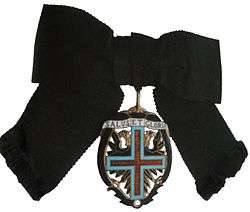Order of the Virtues (Egypt)
The Order of the Virtues (or Nishan al-Kamal) is a female Egyptian order of knighthood, as an award for merit.
| Order of the Virtues Nishan al-Kamal | |
|---|---|
| Awarded by | |
| Type | Order |
| Awarded for | To women as an award for merit |
| Statistics | |
| Established | 1915 Reestablished under the Republic: 1953 |
| Precedence | |
| Next (higher) | Order of Merit |
| Next (lower) | Order of Labour |
Ribbon bar of the Order | |
History
The Order was founded in 1915 and reestablished under the Republic in 1953.
Classes
The order is composed of the following classes of merit :
- Supreme Class
- 1st Class
- 2nd Class
- 3rd Class
| Ribbon bars [1] | |||
|---|---|---|---|
Insignia
- The ribbon is light grey with gold edges.
Notable recipients
- Elisabeth of Bavaria, Queen of Belgium : Supreme class.
- Queen Elizabeth II of the United Kingdom : Supreme class (1948)
- Diana, Princess of Wales : Supreme class (1981)
- Queen Sofía of Spain : Supreme class (1997) [2]
- Infanta Cristina of Spain : Supreme class (2000) [2]
- Queen Aishwarya of Nepal : Supreme class (1974)
- Queen Noor of Jordan : Supreme class (1989)
- Princess Fawzia of Egypt : Supreme class (1939)
- Queen Nazli of Egypt : Supreme class (1917)
- Queen Farida of Egypt : Supreme class (1938)
- Queen Narriman of Egypt : Supreme class (1951)
- Queen Tadj ol-Molouk of Iran : Supreme class (1939)
- Princess Faiza of Egypt : Supreme class
- Princess Faika of Egypt : Supreme class
- Princess Fathia of Egypt : Supreme class
- Princess Noal Zaher of Afghanistan : Supreme class
- Huda Sha'arawi: Supreme Class[3]
References and sources
- World Medals Index, Republic of Egypt: The Order of the Virtues
- Colecciones Militares (Antonio Prieto Barrio), Egypt decorations - p.1
- Foro Dinastías, State visit of Egypt in Spain, Queen Sofia & Cristina
- Harem Years by Huda Shaarawi
gollark: <@!309787486278909952> you are the amdin.
gollark: > Looks like there was an error on sending the password mail. Please contact the admin!when I tried to register.
gollark: Oh, DokuWiki, neat.
gollark: You can still play the original here: https://osmarks.tk/emu-warIf you've not been affected by the IPv4 Wars of course. There are mirrors.
gollark: That was actually just an issue with porting it to osmarks.tk.
This article is issued from Wikipedia. The text is licensed under Creative Commons - Attribution - Sharealike. Additional terms may apply for the media files.
